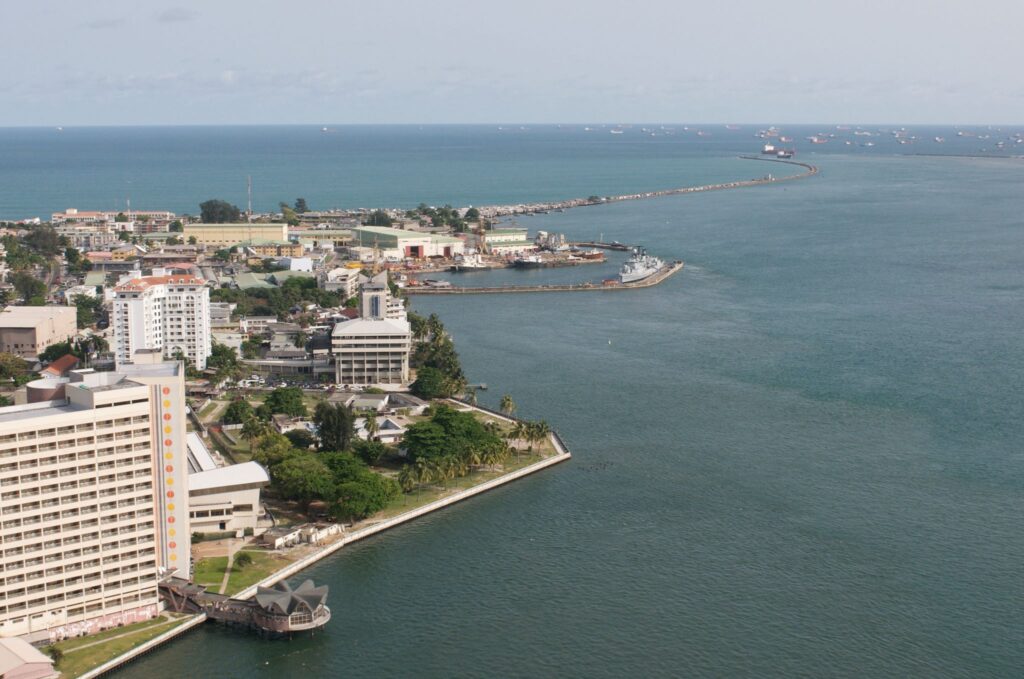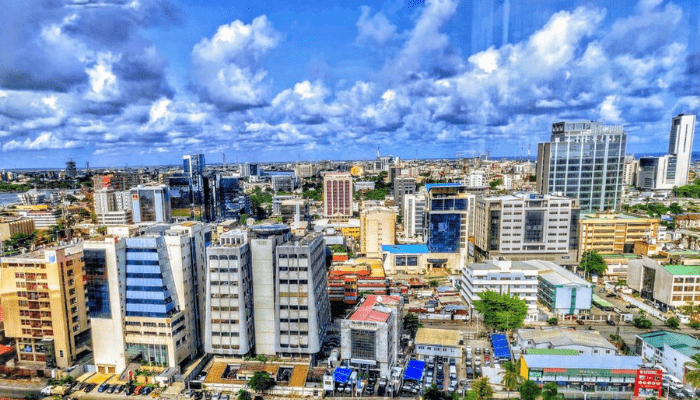This article, How to Stop Victoria Island Lagos Persistent Flood will focus on what should be known about persistent flood in Victoria Island, Lagos and how the Floods are natural disasters characterized by the overflow of water onto normally dry land. They can be caused by various factors such as heavy rainfall, rapid snowmelt, coastal storms, or dam failures. Floods can occur slowly over weeks or quickly within minutes, posing serious risks to lives, property, and infrastructure. Flood management involves strategies like building dams, levees, and floodwalls, as well as improving forecasting and emergency response systems to mitigate their impact.
Victoria Island, situated in Lagos, Nigeria, faces significant flood risks due to its geographical location and urban development challenges. Located along the Lagos Lagoon and the Atlantic Ocean, the island is prone to flooding from storm surges and tidal waves, particularly during periods of heavy rainfall and high tides. These natural factors, compounded by rapid urbanization and poor land use planning, contribute to the vulnerability of Victoria Island to flooding events.

The rapid growth of urban infrastructure on Victoria Island has led to the paving over of natural water absorption areas such as wetlands and mangroves. This urbanization reduces the land’s capacity to absorb excess water, increasing runoff and flooding risks during intense rainfall. Additionally, inadequate drainage infrastructure further exacerbates these challenges. Blocked drains and improper waste disposal practices hinder water flow, causing water to accumulate on streets and low-lying areas during rainstorms.
Seasonal rainfall patterns, typical of tropical climates like Lagos, further intensify the flood risk on Victoria Island. The rainy season, lasting from April to October, brings heavy downpours that can overwhelm drainage systems and trigger flash floods. Moreover, the island’s low-lying topography and ongoing land subsidence, exacerbated by groundwater extraction, contribute to its susceptibility to flooding. Land subsidence increases the likelihood of inundation, even with moderate rainfall, as the land sinks lower over time.
Efforts to mitigate flooding in Victoria Island include improving drainage infrastructure, constructing flood barriers, and promoting sustainable urban planning practices. These measures aim to enhance the island’s resilience against flooding by better managing water flow and minimizing the impact of heavy rainfall events. By addressing both natural and human-induced factors contributing to flood risk, stakeholders can work towards creating a more resilient and flood-resilient environment for residents and businesses on Victoria Island.
Table of Contents
Causes of Flooding in Victoria Island Lagos
- Blocked Drainage Systems:
- One of the primary causes of flooding is the blockage of drainage systems by debris and waste. Improper waste disposal practices lead to the accumulation of trash in drains, obstructing the flow of water during heavy rains.
- Low-Lying Coastal Geography:
- Victoria Island is naturally low-lying and close to sea level, making it particularly susceptible to flooding, especially during high tides and heavy rainfall.
- Inadequate Drainage Infrastructure:
- The existing drainage infrastructure is often inadequate to handle the volume of water during heavy rainstorms. Many areas lack sufficient drainage capacity, leading to waterlogging.
- Rapid Urbanization:
- Rapid development and construction have reduced natural water absorption areas. The increase in concrete surfaces prevents rainwater from seeping into the ground, exacerbating runoff and flooding.
- Climate Change:
- Increasingly erratic and intense weather patterns, attributed to climate change, have led to heavier and more frequent rainfall, overwhelming the drainage systems.
Impact of Flooding
- Property Damage:
- Flooding causes significant damage to buildings, vehicles, and other properties. The cost of repairs and maintenance can be substantial for both residents and businesses.
- Health Hazards:
- Standing water from floods creates breeding grounds for mosquitoes, increasing the risk of diseases such as malaria and dengue fever. Floodwater can also be contaminated, posing serious health risks.
- Transportation Disruption:
- Flooded roads lead to severe traffic congestion and disrupt the transportation network. This impacts the daily commute, delays business operations, and hampers emergency services.
- Economic Loss:
- Businesses suffer from operational disruptions, loss of goods, and reduced customer footfall during flooding events. The economic impact can be far-reaching, affecting the overall productivity of the area.
Mitigation Strategies
- Improving Drainage Systems:
- Upgrading and expanding the drainage infrastructure to handle larger volumes of water is crucial. Regular maintenance to clear blocked drains can also mitigate flooding.
- Proper Waste Management:
- Implementing effective waste disposal and recycling programs can reduce the amount of debris that clogs drainage systems. Public awareness campaigns can educate residents and businesses about the importance of proper waste disposal.
- Urban Planning:
- Sustainable urban planning that includes green spaces and permeable surfaces can help absorb rainwater and reduce runoff. Implementing regulations that control development in flood-prone areas is also essential.
- Flood Early Warning Systems:
- Developing and deploying early warning systems can provide timely information to residents and businesses, allowing them to take preventive measures during heavy rains.
- Community Engagement:
- Engaging the community in flood prevention efforts through education and volunteer programs can enhance the collective response to flooding.
How to Stop Victoria Island Lagos Persistent Flood – PALMACEDAR CLEANING SERVICES CAN ASSIST
Palmacedar Cleaning Services, as a leader in cleaning, janitorial, and fumigation services, can play a critical role in mitigating the flooding issues in Victoria Island. Here are detailed ways in which Palmacedar Cleaning Services can contribute:
Drainage Maintenance and Improvement
- Regular Drain Cleaning:
- Routine Inspections: Palmacedar can conduct regular inspections of drainage systems to identify and address blockages before they become problematic.
- Clearing Debris: Their team can remove debris, leaves, and other materials that obstruct water flow in drains and gutters, ensuring that the drainage system operates efficiently during heavy rains.
- Advanced Cleaning Techniques:
- Hydro Jetting: Utilizing high-pressure water jets to clean and clear out deep-seated blockages within the drainage pipes.
- Vacuum Truck Services: Employing vacuum trucks to remove sludge, sand, and other heavy sediments from stormwater drains.
Waste Management
- Waste Collection and Disposal:
- Scheduled Waste Pickup: Implementing a regular waste collection schedule to prevent waste accumulation that can clog drains.
- Segregation and Recycling: Encouraging waste segregation and recycling to minimize the volume of waste ending up in the drains.
- Public Education Campaigns:
- Awareness Programs: Running educational campaigns to inform residents and businesses about the importance of proper waste disposal and its impact on flooding.
- Community Engagement: Organizing community clean-up events to involve residents in maintaining a clean environment.
Urban Planning and Infrastructure Support
- Collaboration with Local Authorities:
- Joint Initiatives: Working with local government and urban planners to design and implement effective drainage solutions and flood mitigation strategies.
- Consultation Services: Providing expert advice on sustainable urban planning that includes green spaces and permeable surfaces to enhance water absorption and reduce runoff.
- Green Infrastructure Projects:
- Rain Gardens and Swales: Assisting in the design and maintenance of rain gardens and bioswales that help manage stormwater naturally.
- Permeable Pavements: Promoting the use of permeable paving materials in construction projects to allow rainwater to infiltrate the ground rather than run off into drains.
Emergency Response and Flood Management
- Flood Preparedness:
- Early Warning Systems: Collaborating on the development of flood early warning systems to provide timely alerts to the community.
- Response Plans: Establishing comprehensive flood response plans that include immediate cleaning and clearing of affected areas to restore normalcy quickly.
- Post-Flood Clean-Up:
- Rapid Deployment Teams: Deploying rapid response teams to clean and sanitize flooded areas, preventing the spread of waterborne diseases.
- Water Removal: Using specialized equipment to remove standing water from streets, homes, and businesses.
Environmental Protection
- Pollution Control:
- Marine Protection: Implementing measures to prevent waste from reaching marine environments, protecting the local ecosystem and reducing marine pollution.
- Air Quality Maintenance: Managing waste disposal methods to prevent air pollution caused by burning waste.
Customized Solutions for Commercial and Residential Areas
- Tailored Services:
- Commercial Waste Management: Providing customized waste management services for businesses, ensuring efficient disposal and reducing environmental impact.
- Residential Cleaning Services: Offering specialized cleaning services for residential areas to maintain hygiene and prevent pest infestations.
- Sustainable Practices:
- Eco-friendly Products: Using environmentally friendly cleaning products that do not harm the local environment or contribute to pollution.
- Resource Conservation: Implementing practices that conserve water and other resources during cleaning and maintenance activities.
By leveraging their expertise and resources, Palmacedar Cleaning Services can significantly contribute to mitigating flooding in Victoria Island. Their comprehensive approach to drainage maintenance, waste management, urban planning support, emergency response, environmental protection, and customized solutions ensures a cleaner, safer, and more sustainable environment for all residents and businesses. To read more like – How to Stop Victoria Island Lagos Persistent Flood. Visit our blog regularly.









































